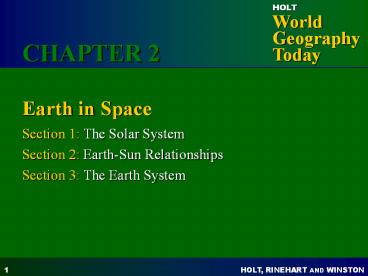Earth in Space - PowerPoint PPT Presentation
Title:
Earth in Space
Description:
CHAPTER 2 Earth in Space Section 1: The Solar System Section 2: Earth-Sun Relationships Section 3: The Earth System Objectives: What is Earth s position in the ... – PowerPoint PPT presentation
Number of Views:233
Avg rating:3.0/5.0
Title: Earth in Space
1
Earth in Space
CHAPTER 2
- Section 1 The Solar System
- Section 2 Earth-Sun Relationships
- Section 3 The Earth System
2
Objectives
Section 1 The Solar System
- What is Earths position in the solar system?
- How do rotation and revolution affect Earth?
3
Earths position in the solar system
Section 1 The Solar System
- one of nine planets
- third planet from the sun
- fifth-largest planet
4
Rotation and revolution
Section 1 The Solar System
- Rotation and revolution affect the amount of
solar energy Earth receives at different
locations. - Rotation on Earths axis produces day and night.
- Revolution around the sun, and the tilt of Earth
on its axis, determines seasons.
5
Objectives
Section 2 Earth-Sun Relationships
- How does the angle of the Suns rays affect the
amount of solar energy received at different
locations on Earth? - What are solstices and equinoxes?
6
Angle of the Suns rays, solar energy, and
location
Section 2 Earth-Sun Relationships
- Direct vertical rays of sunlight concentrate
solar energy in smaller area, making more heat. - Angled rays spread solar energy out, making less
heat. - Earths tilt makes direct rays most common near
equator and less common at high latitudes.
7
Solstices and Equinoxes each occur twice a year
Section 2 Earth-Sun Relationships
- Solsticesaround December 21 and June 21
- Earths poles tilted toward or away from the Sun
- longest or shortest days of the year, depending
on hemisphere - Equinoxesaround March 21 and September 2
- Earths poles not tilted toward or away from the
Sun - equal amount of sunlight in both hemispheres.
8
Objectives
Section 3 The Earth System
- What are Earths four spheres?
- How is Earths environment unique in the solar
system?
9
Earths four spheres
Section 3 The Earth System
- atmospheregases surrounding earth
- lithospheresolid crust of the planet
- hydrosphereEarths water
- biosphereall life forms
10
Earths unique environment
Section 3 The Earth System
- No other planet in the solar system has such a
complex environment. - Environment is the key to human survival and
quality of life.































